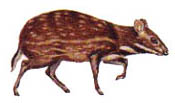New and exciting discoveries occurred in spurts and jumps as the new year begin, and with little time to report on these discoveries, I was left to quickly scratch my head and move onward toward my own research. Leaving the dreams of reporting on the new fossil discoveries of 2008 until I had a little more time. Hence, it is mid-way through the month of February and I have not yet made an entry into the Vertebrate Paleontology blog. Don’t fault me for this lack of attentiveness, as I have been thinking of changing the format of the blog. Either listing all the current vertebrate paleontology articles that come across my desk, with little commentary or become a Gonzo scientist, and offer discussion of my own ideas and thoughts on the subject. Having little time between teaching and writing my PhD dissertation, I neglected my blogging duties, and have let the site decay. Never fear. To make up for it, I have listed all the articles that have come out this year.
Enjoy:
Damiani,R.2008.
A giant skull of the temnospondyl Xenotosuchus africanus from the Middle Triassic of South Africa and its ontogenetic implications. Acta Palaeontologica Polonica 53 (1): 75–84.
Esperante, R., L. Brand, K.E. Nick, O. Poma, M. Urbina. 2008.
Exceptional occurrence of fossil baleen in shallow marine sediments of the Neogene Pisco Formation, Southern Peru. Palaeogeography, Palaeoclimatology, Palaeoecology 257: 344-360.
Finarelli, J.A. 2008.
Testing hypotheses of the evolution of encephalization in the Canidae (Carnivora, Mammalia). Paleobiology 34(1): 35-45.
Friscia, A.R., B. V. Valkenburg, L. Spencer, J. Harris. 2008.
Chronology and spatial distribution of large mammal bones in pit 91, Rancho La Brea. Palaios 23:35-42.
Godefroit,P., Hai, S., Yu, T., and Lauters, P. 2008.
New hadrosaurid dinosaurs from the upper most Cretaceous of north− eastern China. Acta Palaeontologica Polonica 53 (1): 47–74.
Heinrich, R.E., S.G. Strait, P. Houde . 2008. E
arliest Eocene Miacidae (Mammalia: Carnivora) form Northwestern Wyoming. Journal of Paleontology 8(1):154-162.
Hwang, K. M.G. Lockey, M. Huh I.S. Paik. 2008.
A reinterpretation of dinosaur footprints with internal ridges from the Upper Cretaceous Uhangri Formation, Korea. Palaeogeography, Palaeoclimatology, Palaeoecology 258: 59-70.
Kaim, A., Kobayashi, Y, Echizenya, H., Jenkins, R.G., and Tanabe, K. 2008.
Chemosynthesis−based associations on Cretaceous plesiosaurid carcasses. Acta Palaeontologica Polonica 53 (1): 97–104.
Lazzari, V., P. Tafforeau, J.P. Aguilar, J. Michaux. 2008.
Topographic maps applied to comparative molar morphology: the case of murine and cricetine dental plans (Rodentia, Muroidea). Paleobiology 34(1):46-64.
Matson, S.D. and D.L. Fox. 2008.
Can oxygen isotopes from turtle bone be used to reconstruct paleoclimates? Palaios. 28:24-34.
Rana, R.S., Kumar, K., Escarguel,G., Sahni,A., Rose,K.D., Smith,T., Singh,H., and Singh, L. 2008.
An ailuravine rodent from the lower Eocene Cambay Formation at Vastan, western India, and its palaeobiogeographic implications. Acta Palaeontologica Polonica53 (1): 1–14.
Rivals, F., Schulz, E., Kaiser, T.M. 2008.
Climate-related dietary diversity of the ungulate faunas from the middle Pleistocene succession (OIS 14-12) at the Caune de L’Arago (France). Paleobiology. 34(1):117-127.
Sereno, P.C. and Brusatte, S.L. 2008.
Basal abelisaurid and carcharodontosaurid theropods from the Lower Cretaceous Elrhaz Formation of Niger. Acta Palaeontologica Polonica 53 (1): 15–46.
Simmons, N.B., Seymour, K.L. Habersetzer, J. and Gunnell, G. 2008.
Primitive Early Eocene bat from Wyoming and the evolution of flight and echolocation. Nature. 451:818-820.
Valli, A.M.F. and Palombo, M.R. 2008.
Feeding behaviour of middle-size deer from the Upper Pliocene site of Saint-Vallier (France) inferred by morphological and micro/mesowear analysis. Palaeogeography, Palaeoclimatology, Palaeoecology 257:106-122.
Zanazzi, A. and Kohn, M.J. 2008.
Ecology and physiology of White River mammals based on stable isotope ratios of teeth. Palaeogeography, Palaeoclimatology, Palaeoecology 257:22-37.













